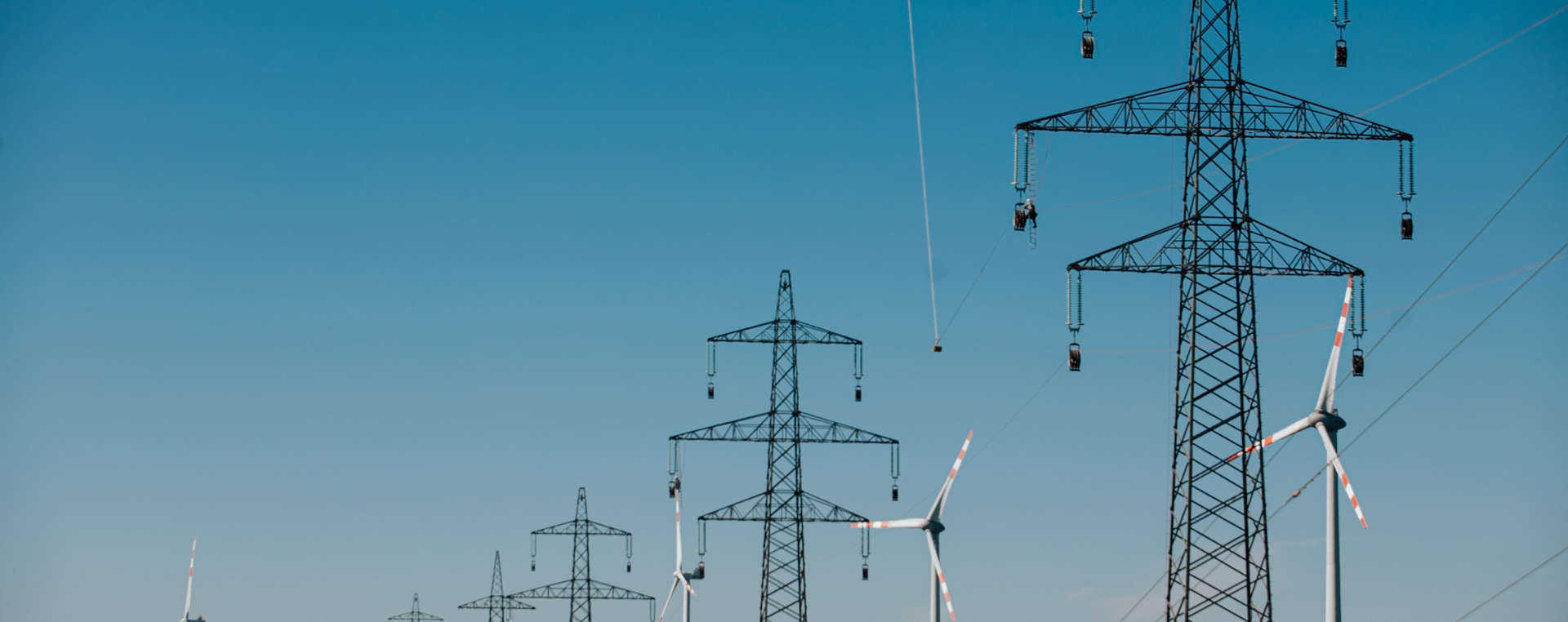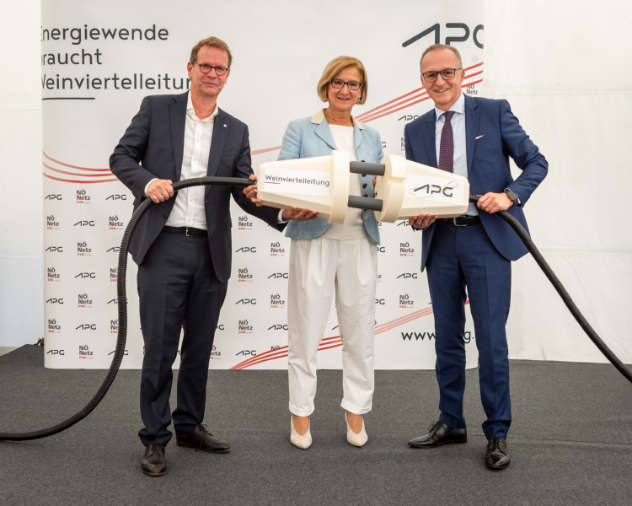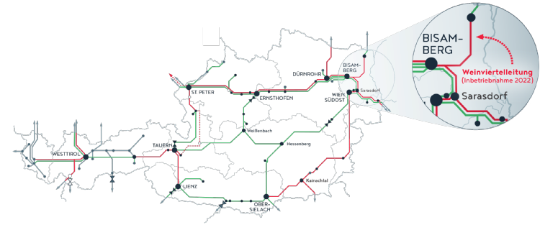
Weinviertel line
With the replacement construction of the Weinviertel line, APG is ensuring a sustainable grid connection now and in the future and thus a secure power supply in your region and throughout Lower Austria.
The new line is a basis for the continued integration of wind and solar energy and its distribution throughout the region and across Austria.
The new Weinviertel line was commissioned in summer 2022 and is making a significant contribution to the success of the energy transition and the electrification of the economy, industry and society.
Project ticker
All current information about the project at a glance.
Project ticker
All current information about the project at a glance.
Open Day
After the Weinviertel line and the Zaya substation successfully started operation last year, APG and Netz NÖ invite all neighbors to an open day at the substations of the Austrian transmission system operator Austrian Power Grid (APG) and the EVN subsidiary Netz Niederösterreich GmbH in Neusiedl an der Zaya on June 2, 2023 from 1:00 - 6:00 pm.
There are no parking spaces available at the Zaya substation. Visitors can park at the sports field and take the shuttle service to the substation every quarter of an hour.
If the open day cannot take place due to weather conditions, you will receive further information here.
Caution: Electric and magnetic fields occur in the high-voltage facility. No access for persons with electromechanical implants such as pacemakers or implanted defibrillators, as well as pregnant women.
Dismantling
Almost exactly four years after the construction decision for the new Weinviertel line, the last foundation of the former existing line has now been successfully removed - thus the dismantling work of the Weinviertel line has been completed.
In the process, some of the 255 pylons of the former existing line were transported away by means of a helicopter. This is not only efficient and time-saving, but also protects the soil.
Dismantling work on the existing pipeline is going according to plan
Immediately after the successful commissioning of the new Weinviertel line in summer 2022, the dismantling work of the existing line has also begun. Part of the pylons will be removed by helicopter and transported away. After a short period of bad weather, the pylon locations in the Weinviertel region, which are only accessible via the ground, have already been dismantled by helicopter.
Thanks to optimised planning and implementation, the project is well on schedule. "The high level of motivation during the elaborate preparations by the project team of the Weinviertel line was matched in no way by the partners carrying out the work, with a remarkable dismantling rate of around 4 pylons per hour (3 approaches per pylon)," praises Andreas Pischel, project manager of the Weinviertel line.
In the meantime, 228 of 255 pylons have already been successfully dismantled. The remaining 27 pylons will be removed at the beginning of next year. In addition to the removal of the pylons, the foundations must also be dismantled. Here, the work is also proceeding according to plan in coordination with the ecological building inspectorates and, of course, the landowners.

Official inauguration and commissioning of the Weinviertel line
The Weinviertel line, and with it the substation at Neusiedl an der Zaya, commenced full operation right on schedule. On 12 September 2022, the informational event for the commissioning was held in Neusiedl an der Zaya. At the invitation of APG, the event was attended by Governor Johanna Mikl-Leitner, EVN board members Stefan Szyskowitz and Franz Mittermayer, Mayor Andreas Keller, APG Supervisory Board Chairman Peter F. Kollmann and APG CTO Gerhard Christiner.
Now that it’s been completed, the Weinviertel line is making a vital contribution to a secure supply of electricity in Lower Austria and in Austria as a whole. Going forward, the line will feed up to 3,000 MW of renewable energy from Lower Austria into APG’s trans-regional grid for use throughout all of Austria. A true milestone in the transition to new forms of energy!
Commissioning
After a construction period of just three years, all work has now been completed. Both the Weinviertel line and the Zaya substation will go into operation in the summer of 2022.
The Zaya substation fulfils an especially important function as additional grid support for Netz NÖ, the regional distribution system operator. The new feed-in station enables the wind and solar power generated in the Weinviertel region to be fed into APG’s trans-regional grid for use across all of Austria.
Project planning and implementation focused on protecting environmental and conservation interests relating to people and nature and on incorporating the existing infrastructure. The new route corridor no longer passes through the Bernhardsthaler Ebene nature reserve, and it also circumvents settled areas.
Construction work enters the home stretch
Construction of the Weinviertel line and the Zaya substation is progressing in leaps and bounds. The line will be commissioned in less than one year.
Erection of the pylons was successfully completed in all three construction sections. Good progress has also been made with the cable work, which is around 75% finished.
Work at the Zaya substation itself has also been going well. The transformers have been upgraded and the building systems are in place, meaning that all buildings, foundations and cable ducts are ready to go. The 380-kV and 220-kV GIS systems have been installed and subjected to high-voltage testing. At present, all plant systems are being tested.
All roads lead to the Zaya substation (transporting transformers)
The transformer is the heart of the substation. Transformers convert the incoming voltage coming from APG’s high-voltage network to a voltage suitable for the regional distribution system operators, and vice versa.
In mid-May 2021, the first transformer reached its new home at the Zaya substation. Weighing in at around 300 tonnes, this massive piece of equipment took several days to reach its destination – just like the later transformers arriving in June and September. The journey started at the Siemens factory in Weiz/Austria. The transformers then travelled by train to Hohenau an der March, where they were crane lifted onto a low loader special transport vehicle that transported them to the Zaya substation and placed them on their foundations.
A transformer named “Carlo”
In July 2021, an old tradition was brought back to life at the substation in Neusiedl an der Zaya – inaugurating a new transformer. The inauguration ceremony was performed by Karl Wilfing, the president of the Lower Austrian Parliament, in the presence of Gerhard Christiner, the Chief Technical Officer (CTO) of APG; Stefan Szyszkowitz and Franz Mittermayer, EVN board directors; mayor Andreas Keller; fire chief Roman Stur, OBI; along with the press. He christened the approximately 300-tonne heavy transformer “Carlo” as per its nickname.
In expressing his satisfaction with the project, President Wilfing said “Just as I am energised by the prospect of our country being on the right track, our new transformer, “Carlo”, will also provide energy to help the energy transition succeed and to ensure a secure and sustainable supply of electricity. That’s why I’m so pleased to sponsor this 300-tonne transformer named Carlo. Carlo is part of Lower Austria’s climate and energy roadmap, and is a good example of how important it is to move from setting goals to getting results.”
62 km
€132m
202
2,100
approx. €200m
Summer 2022
Informational event on the commissioning of the Weinviertel line






Project Roadmap
Commissioning
Weinviertel line and Zaya substation commence operation
Line system
Start of construction on the line system
Start of construction
Start of construction of the Zaya substation
Hearings before the Federal Administrative Court
The EIA approval notice is upheld: the project has officially passed all legal hurdles.
Federal Administrative Court
Proceedings commence before the Federal Administrative Court (BVwG)
Time period for the public to submit comments on the EIA approval notice
EIA approval notice made available for public inspection in all municipalities affected
Approval
Lower Austrian government approves APG’s Weinviertel line
Hearing
Public hearing at the Historismussaal (Reichensteinhof – 2170 Poysdorf, Liechtensteinstraße 1)
Time period for the public to submit comments on the report.
EIA report made available for public inspection in all municipalities affected by the project and in the State of Lower Austria.
Time period for the public to submit comments on the project
Project documentation made available for public inspection in all municipalities affected by the project
Project documentation submitted
Submission of all project documents (application for approval, project description and Environmental Impact Statement) to the environmental impact assessment process with the State of Lower Austria
Planning process
Planning and preparation of the project documentation and the Environmental Impact Statement
Frequently asked questions - FAQ
The new 380-kV Weinviertel line runs from Seyring to the Zaya substation, which was rebuilt in connection with the project. At the Zaya substation, a new connection was made to the 110-kV grid in Lower Austria and to a 220-kV connection extending to the border with the Czech Republic.
APG's new Weinviertel line to replace the existing 220-kV line has had to be subjected to an official approval procedure pursuant to the 2000 Environmental Impact Assessment Act (Umweltverträglichkeitsprüfungsgesetz 2000, UVP-G 2000). The Lower Austria state government was responsible for the approval process, since the planned line will be located exclusively in Lower Austrian territory.
When submitting the project for official review, APG therefore had to prove that the pipeline meets the legal requirements for the protection of people and nature. To prepare the detailed project planning documents, experts from 24 specialist areas carried out inspections at the site of the planned project.
This necessitated accessing private property along the planned line in some cases. The Lower Austrian state authorities granted APG a preliminary works approval notice in April 2015 as the legal basis for conducting the inspections.
Taking the initially planned cooridor as the basis, the corridor was fine-tuned step-by-step over the following 14 months until the current route of APG's Weinviertel line was finalised. In planning the route, the following criteria were of particular importance to APG and its employees:
- the involvement of communities, property owners and other local stakeholders in the planning process;
- consideration of all environmental or conservation interests relating to people and nature; and
- connections with the existing infrasturcture (Lower Austrian grid's 110-kV line, wind farms, etc.).
In addition, the many in-person discussions that APG project employees held with representatives of the communities along the route, the property owners affected and neighbouring parties were a crucial part of the overall planning process. This was the only way to come up with potential improvements to the proposed route plan and to discuss them with the parties involved at a local level. Many of the suggestions from the community and the property owners were incorporated into the plans and are now reflected in the probable route of APG's Weinviertel line replacement.
It was of great importance to Austrian Power Grid AG (APG) that individual stakeholders have been informed at an early stage during the entire duration of the “APG Weinviertel line replacement” project.
Of particular significance was involving the public in the route development process, providing comprehensive information on the individual project steps, ensuring open communication and working together constructively with members of the public and their political representatives.
The project team began initiating personal contact with the property owners at the same time the info letter was sent. To ensure that the process would be as simple as possible with direct contact and support during the entire duration of the project, the project area was divided into five sections, with each section being assigned to an APG employee as the direct contact person for the property owners. The contact information of the APG contact person responsible for each section was supplied to all property owners in the initial info letter.
One of the main requests received during the many discussions with property owners, neighbouring parties and community representatives during the planning phase related to optimising the placement of the pylons as well as the route. The discussions were successful in identifying potential improvements that could be taken into consideration in the route now defined.
At the end of the planning phase, all of the communities affected by APG’s Weinviertel line replacement were invited to a consultation day at which information was provided to all interested parties. Local residents were invited to attend the consultation day in their community through flyers circulated by bulk mail or ads in community newspapers, while property owners were sent individual letters.
In addition, a project folder containing information on each of the project phases was made available to interested parties.
In principle, a property can be claimed either by a pylon site itself or by an overvoltage - in this case, only the conductor cables and the associated servitude area run across the property. How the agricultural and forestry land claimed was compensated was regulated uniformly for all landowners in the APG Directive. Ensuring a uniform procedure and equal treatment of all landowners is a top priority for APG.
The guideline regulates the calculation of the amount of compensation for the easement agreements to be concluded with the landowners under private law and by mutual agreement. APG's guideline ensures a uniform, appropriate and cooperative approach to the assertion of land claims for the replacement construction of the APG Weinviertel pipeline and is divided into three sections:
- agricultural land
- forestry land
- general
If the claimed area was a plot of land used and dedicated for agricultural purposes, the compensation amount was determined on the basis of the guidelines. The different market values in the project region were also taken into account.
If the claimed area was a forest that had to be felled in the course of the construction of the powerline or during operation, the amount of the compensation payment was assessed by an expert on the basis of the Directive. The valuation was carried out according to the recognized methods of forest value calculation.
APG also undertook to compensate the damage to the land caused by the construction of the pipeline in accordance with the "Compensation guidelines for the use of agricultural and forestry land" issued by the Lower Austrian Chamber of Agriculture.
The Environmental Impact Assessment (EIA) is made in an integrated approval process. That means that once an application for approval of a project is submitted, the responsible EIA authority (in the case of the Weinviertel line it was the Lower Austrian provincial government) proceeds to apply all substantive laws relevant to the project in an integrated procedure. The EIA authority then decides on the eligibility of the project for approval. In making the decision, extremely strict criteria are applied regarding the impact on people and nature.
Contact person

Andreas Pischel
Project lead
Stefan Walehrach
Project communication
Project information
The Weinviertel line is essential for the success of the energy transition. It feeds the increasing amount of wind power from the Weinviertel region into APG's supra-regional grid and make it usable throughout Austria. APG has invested around 200 million euros in the economic and living environment of Lower Austria.
The new line improves energy security and strengthen stability of supply in your region and in all of Lower Austria. Integrating wind and solar energy from the Weinviertel region into the grid is a key contribution to reaching the targets set in Lower Austria’s 2030 Climate and Energy Plan as well as the Austrian climate and energy targets.
The existing line was in need of renovation due to its long service life (around 70 years) and the route was no longer optimal for future requirements. It was therefore necessary to develop a new route that takes into account the geographical development of the power generation side: The new APG Weinviertel line runs from Seyring as a 380 kV line to the Zaya substation, which was newly constructed as part of the project. A new connection to the Lower Austrian 110 kV grid and a 220 kV connection to the Czech border were established at the Zaya substation. The Weinviertel line and the Zaya substation were successfully connected to the grid in summer 2022.


